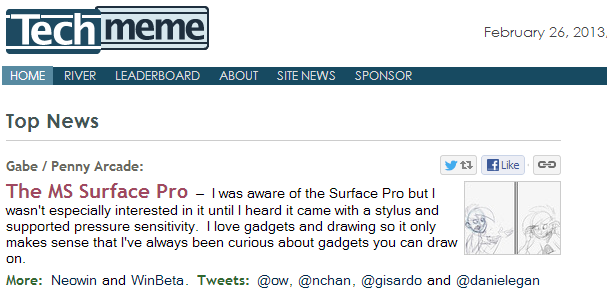Penny Arcade’s Influence On Tech Products Versus Forrester Research
Your perpetually-connected customers are seeking information from a much broader range of sources than ever before. If you just work with the same traditional influencers you have for years — industry analysts and mainstream media — your message risks getting lost in a sea of noise. Instead, leading marketers are identifying key online influencers for their products and marketing to them specifically. These influencers are highly specific, and are not the same for any two products or solutions, or even two different audiences of a single product.
The value of reaching out to a non-traditional list of influencers was illustrated this week by Microsoft’s marketing campaign for the new Surface Pro.
Mike “Gabe” Krahulik is the author of the long-running Penny Arcade, a popular webcomic about video game culture. He said on Twitter he was “interested in the Surface Pro,” and due to the target audience and popularity of his comic, Microsoft sent him a demo unit. Gabe’s not a technology journalist; he’s not an industry analyst; he’s just someone with a passionate and tech-savvy following — a following which includes perpetually-connected customers who influence technology purchasing.
What happened next? Gabe wrote a full-length, relatively positive, review of the Surface Pro and its applications for media professionals that was not only read by his audience, but became a top link on TechMeme, a tech news aggregator.
Compare that to traditional influencers, Analysts at Forrester Research, who might also receive a Microsoft Surface Pro in the mail to become knowledgable about the product. As traditional influencers, Analysts still have a very important place in your marketing mix. However, to fully address consumer (not just business and press) customers, you must broaden your target influencer lists.
Influencer marketing (and word-of-mouth marketing) is built on much more than just free products — it's about learning who's influential for your target audience(s) and building real relationships with them. And your products often have multiple target audiences; for example, the Surface Pro's consumer customers and business customers seek out and are influenced by very different sources.
I look forward to discussing influencer marketing with you in the comments on this blog, on Twitter, and at our Marketing Leadership Forum in Los Angeles April 18-19 or in London May 21 & 22. I will be speaking about how to engage with your key influencers at both events.
